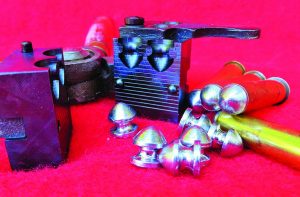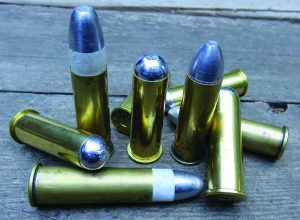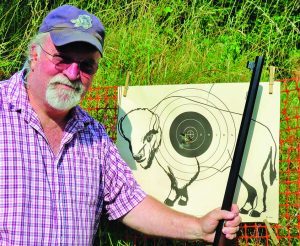By Mike Nesbitt | Contributing Editor

Lyman’s mold for the collar button bullets, with bullets in front.
In 2014 Lyman re-introduced molds for their #457130 bullets; those are the Collar Buttons. This strange and very unique looking bullet weighs only 145 grains when cast and it was designed to weigh the same as a .457” round ball. The original purpose for this bullet was to give our troopers some good shooting practice during inclement weather because they’d shoot their .45/70s with this bullet loaded over only 5 grains of loose blackpowder right inside the barracks.
My favorite ideas for such short range loads include the possible taking of small game while on a big game hunt. Those would be for the incidental grouse or rabbit that might be encountered while hunting other game and the short range loads could do their part in adding to the camp menu.

.50/70s loaded with round ball, grease groove and paper patch bullets.
Joining me with some of these ideas was Jerry Mayo and he tailored some of the Collar Button loads for his .45/70 from C. Sharps Arms. Rather than using the 5-grain powder charge, Jerry upped the dose of powder to 10 grains and used GOEX’s Olde Eynsford 2F. The Collar Buttons were sized to .457” and lubed with Big Sky Lube; then they were ready for some shooting.
I tried to do something similar for my .50/70. The .50/70s were just loaded with a single .512” round ball. Those round balls were loaded into the cases’ mouths after the brass was charged with 10 grains of the Olde Eynsford 2F and slightly crimped in the middle of the ball, at its full diameter.
Rather than simply shooting them up, we gave these loadings some formal testing. Five of them were fired at a paper target, posted at just 25 yards, and those five shots were fired across a chronograph so we gathered info on speed and accuracy at the same time. Out of Jerry’s 30-inch barreled .45/70 Sharps, the collar buttons with the 10 grains of OE 2F sailed across the chronograph at an average of 645 feet per second. He put all five of his shots in a nice tight cluster in the 10 and 9 rings of the target, just a touch left of center. That is very good and it showed a lot of small game potential—rabbits and grouse come to our minds.
My .50/70 loads with the round balls were fired out of my ’74 C. Sharps Arms Hartford Model with a 26” barrel. Those “skidded” across the chronograph at only 475 feet per second but they also printed rather well on the target at 25 yards. In my string of just five shots, there was one slow and slugging round which was clocked at just 432 fps. On my target there is one shot that was able to sneak out of the black, hitting low at 6 o’clock. We can’t be sure, because the shots were not “spotted” when fired, but I must guess that the low hit was the same round that had the lowest velocity. Actually the .50/70 performed quite well.
Our next step was for each of us to take just five rounds of these light loads and proceed down a “trail-walk” that has metal silhouettes hanging along-side the trail. This trail-walk is mainly for muzzle-loaders firing round balls, for either competition or just for fun, and our light loads actually offered far less in velocity and range, so those targets certainly were not damaged. Shooting at those trail-side gongs was a real ball! And it was a very interesting way to get some offhand practice with our Sharps rifles.

Here is Mike’s 26-inch barreled Sharps in .50/70 caliber, a handy rifle.
Jerry and I made an agreement when we started down the trail, that we’d pick targets we could hit and that we would not miss with any shots. That agreement was kept very well and quite easily. One target that seemed outstanding to me was a pistol target, a small rabbit that is mounted to a coil spring. The rabbit target demanded a good hold and a careful trigger squeeze, but we both hit it. That was a 20-yard shot, through the timber, you might say. Another target that deserves mention was the “cougar head” because it was probably our longest shot along the trail at about 30 yards. The cougar head was actually far enough away that we could “hear” the difference in speed between our loads with the .45/70 collar button “getting there” much quicker than the .50/70’s round ball. Even so, we both made good hits.
Our shooting along the trail more or less proves the practical value of these light loads, even while their application is just as limited as their velocities. But there is nothing limited in getting some good offhand practice. And it would not be out of order to use them on small game while on a big game hunt. Carrying one or two of these loads while on a more serious outing could add both memories and excitement to the hunt as well as contributing something to fry or roast over the campfire.
Finding a new mold to make the .45 caliber collar buttons is not hard. Just look for or order a mold from Lyman for #457130. Lyman will also sell direct to you from their website. To contact Lyman directly, perhaps to request their catalog, write to them at: Lyman Products Corporation, 475 Smith Street, Middletown, CT 06457. You can also visit their website at: Lymanproducts.com.

Jerry Mayo is pleased with his 5-shot group with the round balls at 25 yards.
Shooting the .50/70 with the round ball over just 10 grains of OE 2F powder was very much like shooting the .45/70 with the collar button bullet. The fact that the round ball had no lubrication at all didn’t seem to “slow it down” at all. The biggest difference was that the .50/70 was a bit dirtier than the .45/70 after the shooting was done.
Getting a round ball mold to make .512” round balls really isn’t that hard either but more than likely not as popular as getting the collar button mold. The best source for a .512” round ball mold is one of the muzzleloading supply houses and Dixie Gun Works comes to mind right away. Another maker of “bag molds” (round ball molds that go right into the shooting bag) is Larry Callahan and I do recommend his bag molds. Look at the Callahan molds online at: bagmolds.com.
Short-range bullets have always appealed to me, probably because I’m just a rabbit hunter at heart. But those short-range bullets and loads give a big-bore blackpowder cartridge rifle a whole new character as well as a widely expanded range of use. On top of that, shooting the short-range bullets is simply a lot of fun.



